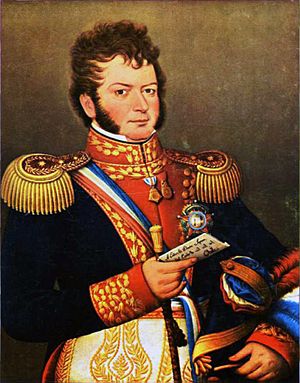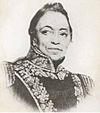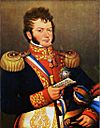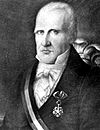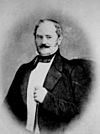Supreme Director of Chile facts for kids
Quick facts for kids Supreme Director of Chile |
|
|---|---|
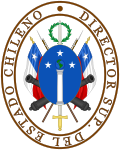
Seal of the "Supreme Director of the Chilean State"
|
|
| Style | His Excellency |
| Precursor | President of the National Government Junta of Chile |
| Formation | 7 March 1814 |
| First holder | Antonio José de Irisarri |
| Final holder | Ramón Freire |
| Abolished | 9 July 1826 |
| Succession | President of Chile |
The Supreme Director of Chile was like the main leader of the country, acting as both the head of state and the head of government. This important role existed in Chile during two periods: first in 1814, and then from 1817 to 1826.
The very first Supreme Director was Francisco de la Lastra. However, before him, Antonio José de Irisarri held the title for just seven days as a temporary leader. The last person to be called Supreme Director was Ramón Freire.
Contents
History of the Supreme Director Role
The Old Fatherland Period (1814)
In 1814, Chile was fighting for its independence. Royalist forces, who supported the King of Spain, were advancing. Because of this, the National Government Junta, which was a group of leaders, was ended.
The idea was to create a new position, the Supreme Director. This single person would have all the powers of the previous Junta and its President. This was meant to help organize the forces fighting for independence more easily. A group called the Consultative Senate was also created to advise the Director.
On March 7, Francisco de la Lastra was named the first Supreme Director. But he was in Valparaíso at the time, not in Santiago, the capital. So, Antonio José de Irisarri from Guatemala stepped in as a temporary Supreme Director for seven days. De la Lastra finally arrived in Santiago on March 14 and took over.
A set of rules from 1814 said that the Supreme Director would have "extensive and unlimited" powers. However, for big decisions like peace treaties, declaring war, or setting taxes, the Director had to talk with and agree with the Senate. The Supreme Director was supposed to serve for 18 months, with a chance to stay longer if the local government and Senate agreed.
On July 23, 1814, General José Miguel Carrera, who had been a President of the Government Junta before, led a sudden change in government. He worked with a Catholic priest named Julián Uribe. They removed de la Lastra from power, ended the Supreme Director system, and set up a new Government Junta with Carrera as its President.
The New Fatherland Period (1817-1823)
In 1817, the Royalist forces were defeated at the Battle of Chacabuco. After this important victory, Bernardo O'Higgins became the Supreme Director. At first, he was the leader de facto, meaning he was in charge even without a formal law. Later, when the Provisional Constitution of 1818 was put into place, it officially confirmed him as the Supreme Director.
The Constitution stated that the Supreme Director would hold the main power across the entire country. It also mentioned that future Directors would be chosen with the agreement of the different regions of Chile.
Organizing the Republic (1823-1826)
By early 1823, General Ramón Freire, who was a military leader in Concepción, Chile, marched his troops towards Santiago. On January 28, O'Higgins stepped down as Supreme Director. A temporary Government Junta was then formed, led by Agustín Eyzaguirre.
However, Freire and his troops were in Valparaíso and refused to accept the new government. They marched towards Santiago. Eventually, Freire was named Supreme Director on August 18. He held this position until July 9, 1826. After him, Manuel Blanco Encalada became the first President of Chile.
During Freire's time as Director, a new Constitution was created in 1823. This Constitution said that the Supreme Director would manage the country according to its laws and would be the only person with executive power. The Director would serve for four years and could be re-elected for a second term if two-thirds of the votes supported it.
List of Supreme Directors
- Political parties
Independent
Pelucones
Pipiolos
| No. | Portrait | Name (Born-Died) |
Term | Political Party | Election | Ref. | ||
|---|---|---|---|---|---|---|---|---|
| Took office | Left office | Duration | ||||||
| 1 | Antonio José de Irisarri (1786–1868) |
7 March 1814 | 14 March 1814 | 7 days | Independent | – | ||
| 2 | Francisco de la Lastra (1777–1852) |
14 March 1814 | 23 July 1814 | 131 days | Independent | – | – | |
| Spanish Reconquest (1814–1817) |
||||||||
| 4 | Francisco Ruiz-Tagle (1790–1860) |
12 February 1817 | 16 February 1817 | 4 days | Pelucones | – | – | |
| 5 | Bernardo O'Higgins (1778–1842) |
16 February 1817 | 28 January 1823 | 5 years, 346 days | Independent | – | ||
| 6 | Agustín Eyzaguirre (1768–1837) |
28 January 1823 | 4 April 1823 | 66 days | Independent | 1822 | ||
| 7 | Ramón Freire (1787–1851) |
4 April 1823 | 9 July 1826 | 3 years, 96 days | Pipiolos | 1823 | ||
See also
 In Spanish: Director supremo de Chile para niños
In Spanish: Director supremo de Chile para niños


